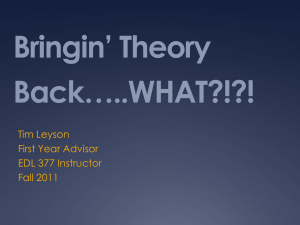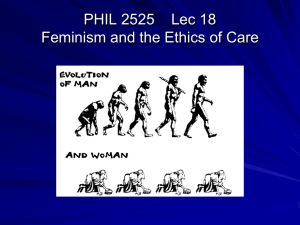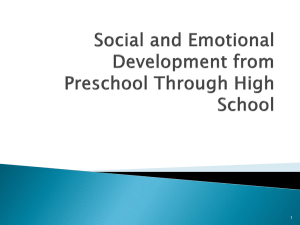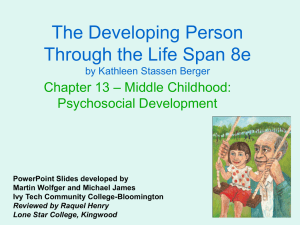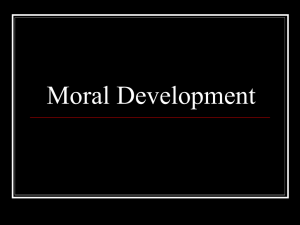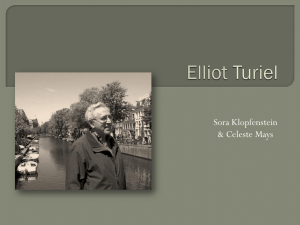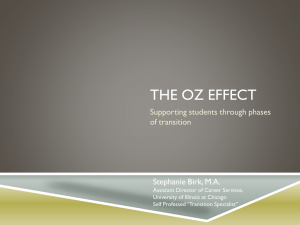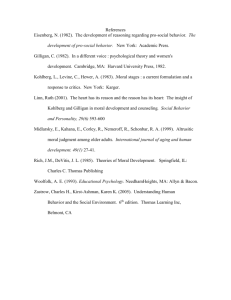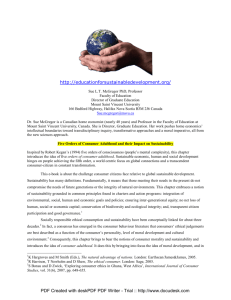DevelopmentalTheory_Notes from Class
advertisement
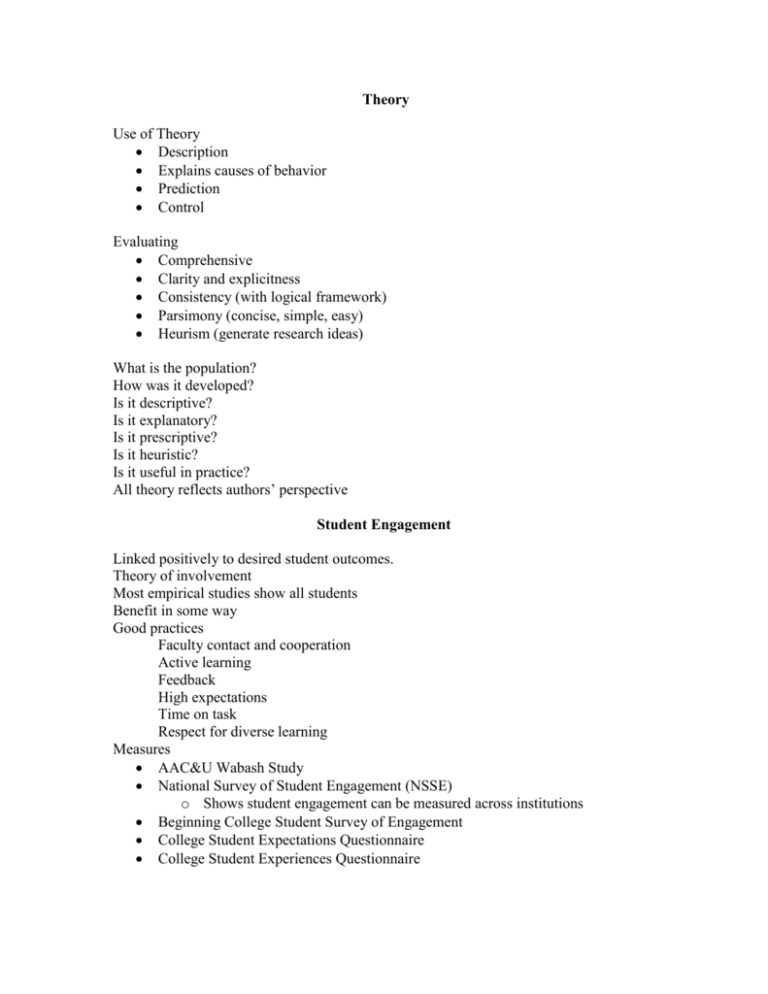
Theory Use of Theory Description Explains causes of behavior Prediction Control Evaluating Comprehensive Clarity and explicitness Consistency (with logical framework) Parsimony (concise, simple, easy) Heurism (generate research ideas) What is the population? How was it developed? Is it descriptive? Is it explanatory? Is it prescriptive? Is it heuristic? Is it useful in practice? All theory reflects authors’ perspective Student Engagement Linked positively to desired student outcomes. Theory of involvement Most empirical studies show all students Benefit in some way Good practices Faculty contact and cooperation Active learning Feedback High expectations Time on task Respect for diverse learning Measures AAC&U Wabash Study National Survey of Student Engagement (NSSE) o Shows student engagement can be measured across institutions Beginning College Student Survey of Engagement College Student Expectations Questionnaire College Student Experiences Questionnaire What makes a difference in college? Faculty o Class assignment require integration o What they thing and value Institutional policies and practices that promote engagement high impact activities Attending MSIs (minority servicing institutions) o Student abroad o Learning communities o Distance learning o Working on campus Psychosocial Identity Development Erikson’s Identity Development Theory Pioneer clinical psychologist (adolescence through adulthood) Based on Freud Identity development external as well as internal Eight stages of development set off by crisis o Stage 1 = trust/mistrust o Stage 2 = autonomy/shame and doubt o Stage 3 = initiative/guilt o Stage 4 = industry/inferiority o Stage 5 = identity/identity diffusion o Stage 6 = intimacy/isolation o Stage 7 = generativity/stagnation (continue to grow) o Stage 8 = integrity/despair Identity changes with crisis Highly descriptive but hard to study Marcia’s Ego Identity Statuses Grounded in Erickson First empirical prototype Critical variables o Exploration o Commitment o Sexual decisions Identified four identity statuses o Foreclosure – (no crisis/commitment) o Moratorium – (crisis/no commitment) o Identity achievement – (crisis/commitment) o Diffusion – (no crisis/no commitment) Josselson’s Theory ( 1971) Identified development for women Studied 60 women, seniors 20-22 from 4 colleges over 30 years, follow up study of 30 in 1996 spanning 22 years Identified o Foreclosures – Guardians o Identify achievements – path makers o Moratoriums – searchers o Identity diffusions- drifters Gender Differences Constantinople claimed men developed more psychosocial maturity Others found women scored higher Resolve processes of intimacy differently: men’s competence through career choice, women through relationships Arthur Chickering Built on Erickson’s identity and intimacy Reisser joined in 1993 Saw identity established as core developmental issue of students First Research 1959-1965 Proposed 7 vectors of development Students move at different rates no linear or solo Vectors: Developing competence Managing emotions Moving through autonomy toward interdependence Developing mature interpersonal relationships Establishing identity Developing purpose Developing integrity Chickering and Specific Populations Women’s development different from men’s interpersonal relationships; later for men; autonomy later for women Women higher intimacy and more tolerant at start of college HBCUs: women higher than men on interpersonal relationships, autonomy and life purpose, however men higher in identity development of four years Student Affairs Applications: Programming Needs assessment Evaluation of program impact Individual interactions Advising Environmental interventions Residential learning Relationship to faculty Collaboration with other students Chickering Critique Failure to address Asian and Native American students Lacks specificity and precision – too general Failure to address motivational levels Multicultural issues not covered adequately Overall significant impact, easy to understand and use Most well known Intellectual and Ethical Development William Perry (1968, 1981) Research on how students make meaning of teaching and learning (what was it about his sample?) Perry’s “scheme” simplistic to complex Nine positions o Dualism – black or white o Multiplicity – honoring diverse views o Relativism – opinions not equal o Commitment – initiates ethical development There may be stops, regressions, “timeouts” First Assessment of themes qualitative – time Knefelkamp and Widick created Measure of Intellectual Development, Baxter Magolda and Porterfield Measure of Epistemological Reflection All measure first five Used widely in literature as outcomes measure Applications of Perry Informal assessment The developmental instruction model (DI) Classroom – (difference in undergraduate and graduate) Student Affairs – residence halls, career planning, advising Critique of students Date of study Narrow/wide range of students Including both intellectual and ethical development Influenced Belenky, Clinchy, Goldberger, and Tarule work on women, BaxterMagolda’s work on women and men, King & Kitcherner reflective judgment: Parks faith development Labels Moral Development Kohlberg, Rest and Gilligan Transformation in form or structure of thought Dominant for over 40 years Based on psychology and moral philosophy Focuses on process, not content Stages on moral reasoning (6 stages, 3 levels) o Pre-conventional – no understanding of rules o Conventional-identify with rules o Post-conventional or principled – separate, self-choice Based on Piaget and Rawls Rest (1979) Objective measure of moral development (DIT) defining issues test Adapted Kohlberg Examined two elements of thinking; how expectations are known and shared; how interests are balanced View more broad than Kohlberg, more complex (percentages within “stages”) Developed schemas; personal interest, maintain norms, post-conventional Application of Kohlberg moral education, “just communities” cognitive conflict to develop higher-level thinking research supportive college friends connects with growth in moral judgment; others show very little gain in Greek organizations with one exception Gilligan and Women’s Moral development (1982/1993) significant departure from Freud (women as deviant, men standard, Kohlberg using results from men-women later, but still found “underdeveloped” In a Different Voice (30 years, girls and relationships) Themes of care and justice Three levels and two transitions o Orientation to individual survival, transition; selfishness to responsibility o Goodness as self sacrifice; transition goodness to truth o Morality of non-violence SA Applications for Gilligan o Ethic of care o Examining underlying assumptions in policies and structures o Staff development to recognize balance necessary o Justice: power, domination, assertiveness, strength, control of emotions, independent leadership o Care: involvement, interdependence, concern for relationships, sharing information, inclusion Five perspectives for women Silence Received knowledge Subjective knowledge Procedural knowledge Constructed knowledge Belenky, Clinchy, Goldberger, Tarule Influenced by Gilligan and Perry Ways of knowing are perspectives, not stages “voice” used to describe intellectual and ethical development Student affairs can emphasize connection rather than separation Theory has relevance in classroom and student affairs-connected thinking Model of epistemological Reflection Cognitive development measure that included both men and women Longitudinal study Contains four stages o Absolute knowing – knowledge certain o Transitional knowing – acceptance that knowledge not certain o Independent knowing – mostly uncertain o Contextual knowing- convergence of gender-related patterns More similarities than differences between men and women Absolute, first year; transitional, sophomore, junior and senior; independent, graduate Not based on diverse populations Social construction evident Applications are four major findings o Validating students as knowers o Situating learning with experience o Jointly constructed meaning o Relational aspect of these three crucial Work combines men and women, emphasizes practice King and Kitchener (1994) Reflective Judgment Model ten-year longitudinal study, 80 participants, interviews o How do people decide what they believe about problems? o Seven stages Pre-reflective thinkers-do not recognize uncertainty Quasi-reflective thinkers – difficulty with reasoned conclusions Reflective thinkers – active construction of knowledge Kolb’s Theory of Experiential Learning (1984) Kolb describes as adult development Roots in Dewey, Lewin and Piaget, Jung Explores the role of experience in the learning process Defines learning as: “the process whereby knowledge is created through the transformation of experience.” Learning as four-stage cycle-series of steps o Concrete experience – CE (feeling) o Reflective observation – RO (watching) o Abstract conceptualization – AC (thinking) o Active experimentation- AE (doing) Form a habitual way of responding to the learning environment o Different preferences for polar opposites Four learning styles emerge o Convergers (AC and AE – good problem solvers who tend to be technically oriented) o Divergers (CE and RO- imaginative, meaning and values oriented) o Assimmilators (AC and RO – inductive reasoners, create theories by integrating disparate ideas) o Accommodators (CE and AE – doers, implementers, risk takers) Believed learning style set the course for personal development along stages: o Acquisition o Specialization o Integration Learning Style Inventory (LSI) o 12 items related to learning o Concerns raised by two-dimensional structure o Revised in 1993 o Informal assessment done by asking participants to relate to styles Applications o Counseling o o o o Career planning Staff development Orientation Classroom/workshop situations Integrative Theories Ecological Kurt Lewin (1936) Behavior = Person’s Interaction with the Environment Basis of Ecological Models o Human ecology- Interrelationship of humans with environment Lays foundation Ecology defined as adaptation to environment Understanding ecosystems Greenhouse analogy o Developmental ecology –(Bronfenbrenner, 1979, 1989, 1993) psychological approach environment and its influence on development of person Comes from psychological perspective Adapted Lewin – development is a function of the interaction of a person and environment Focus on individual interaction – environment is the context o Campus ecology – reciprocal relationship between student and campus environment Introduced by Banning & Kaiser Study of relationship between student and campus environment Different components-theories Behavior setting – Barker (1968) People behave in similar ways in specific environments Subculture approach – Walsh (1978) – describes environment by attitudes, values, roles of members Personality types – Holland (1966) shifted weight to person College culture (1970) culture is formed by accumulation of behaviors across individuals o Theories Social ecological approach (Moos, 1973,1979) measured physical and architectural Transaction approach (Pervin, 1967, 1968) –behavior can be understood by transactions between individual and environment All approach integrated by Strange and Banning (2001) for campus design Self-Authorship Constructive – Developmental Theories Keagan (1982-1994) Theory of self-evolution, evolution of consciousness Based on Piaget, but added developmental portions Development is effort to resolve tension between desire to be different and desire to be immersed in the environment Levels of Consciousness o Order 0 – infants o Order 1 – Childhood o Order 2 – instrumental mind – thinking more logical o Order 3 – socialized mind- relating across categories- dualistic o Order 4 – Self-Authoring Mind ( college aged student, reasonable expectation) o Order 5 – Self-Transforming mind Modern life required fourth order consciousness – self-authoring – the ability to generalize across abstractions deciding on your owntaking ownership Baxter Magolda (1999 – 2008) Self-authorship Definitely longitudinal Identified phases o Following formula o Crossroads o Becoming the Author of One’s Life – Kegan similar o Internal foundation- spirituality may play role – voice Outcomes o Learning partnerships model used in student affairs Faith and Spirituality Fowler (1978) o Influenced by Kohlberg and Piaget o Stages Primal Intuitive-projective Mythic-literal Synthetic-conventional – still seeks external individuative-reflective- self authored – young adulthood conjunctive – midlife and beyond universalizing –rare Parks (1986a) o Considers role of higher education o Forms of knowing (2000) Authority-bound (dualistic) Unqualified relativism (relativism) Probing commitment Tested commitment – advanced adulthood Conventional commitment – midlife Schlossberg Transition Theory (1984) Theory of adult development o Four categories Contextual perspective Developmental Life span Transitional perspective Transition defined as: “any event, or non-event, that results in changed relationships, routines, assumptions and roles” Additional part of the process is coping Application shown in Cormier and Hackney counseling model (1993) assisting individuals in transition Cormier and Hackney counseling model Five stages: relationship building, assessment, goal setting, interventions, termination and follow up Egan (1994) model: exploration, understanding and coping Many areas for application in college students Holland’s Theory of Vocational Personalities and Environments (1985/1992) Both typology and person –environment Six basic personality types Six corresponding environments Success depends on proper “fit” Popular in career development Work as vocational counselor Six personality types o Realistic (manual, mechanical, technical) o Investigative (science and mathematics) o Artistic (language, art music, drama, writing) o Social (educate, inform, enlighten) o Enterprising (leadership, persuasion) o Conventional (clerical, computational) Vocational Preference Inventory (1985) o Includes 160 occupational titles o First instrument developed for personality type Self Directed Search (1994) o Self-administrated, self scored instrument Seems to fit vocational choice Gender, race and culture differences shown-most regarding distribution Applications o Career development o Counseling o Orientation and advising o Residence life o Student activities Myers-Briggs Adaptation of Jung’s Theory Personality Type (1923/1971) Indentifies individual differences in how people take in and process information Carl Jung, psychoanalyst o Myers and briggs studied more than 20 years o Developed myers-briggs type indicator o Keirsey and Bates (1984) expanded MBTI Most extensively used for assessing personality type Each item related to one of four preferences o Extraversion-introversion o Sensing-intuition o Thinking-feeling o Judging-perception Keirsey Temperament Sorter (1984) Derived from MBTI Instrument shorter and more readily available Cautions remain for validity Critiques Few studies on racial differences Consistently found that African American students more sensing and thinking that white students Hispanic adults more feeling and extravert More women feeling than thinking (men) Gender and racial bias possible cause Applications o Career choice o Residence life o Discipline o Counseling o Advising o Learning and teaching styles o Retention Social Identity Development How does ethnicity, race, gender, sexual orientation, and other social identities affect my life? Key Concepts Privilege and Oppression o Mostly invisible to those who possess it o McIntosh (1989, 2003) o White privilege o Social class privilege o Gender privilege o Heterosexual privilege o Ability privilege o Christian privilege Multiple Identities o Conceptual Models (Jones and McEwen (2000)); Abes, Jones, and McEwen (2007) Diversity Development o Model: Chavez, Guido-DiBrito, and Mallory (2003) Racial Identity Models Cross and Fhagen-Smith’s Model of Black Identity Development ( 2001) o Foundation in Cross (1991) five stage to four stage model o Life span model of developing black identity o Three patterns Nigrescence Pattern A – establishing identity through interaction with parents and others, birth through adulthood Nigrescence Pattern B – not socialized, conversion in adulthood Nigrescence Pattern C – expansion or modification during adulthood o Helms’s Model of White Identity Development (1992) Most widely known Created to raise awareness of the role of white people Two phases – abandonment of racism and evolution of a nonracist identity o Rowe, Bennett and Atkinson’s White Racial Consciousness Model (1994) Awareness of being white and implications for relationships with those who are not white Derived from Phinney (1989) o Rowe et al. Types of attitudes – unachieved white racial consciousness and achieved white racial consciousness o Ferdman and Gallego (2001) - Latino Identity Development Race secondary to cultural and ethnic distinctions o Kim – Asian American Identity Model (1981, 2001) Asian American identity and white racism not mutually exclusive, unlearn stereotypes, positive identity essential Horse (2001) American Indian Identity Development o Role of colonization essential o Characterizes consciousness Language and culture Validity of genealogical heritage Adopting a worldview respecting traditions and philosophical values Ethnic Identity and Acculturation Socially constructed like race? (Barth, 1969) Grounded in ego identity (Erickson, 1968) External and internal o External – language, media, transitions, friendships, functions o Internal – Cognitive, moral, affective Acculturation o Changes related to adaptation Phinney (1990) Model of Ethnic Identity Development o Based on Erickson-consistent with Marcia o Three-staged model focused on commonalities Torres et al. (2003) Ethnic Identity of Lations/Hispanics/Chicanos o Rapid increase in research last 15 years o Early research (1999) focused on biculturalism o Through sophomore year in college Asian/Americans o Most ethnically diverse group o No linear model applies o Recommend against generalization Native Americans/American Indians o Indigenous Americans o Customs tribe o Dominant culture at odds with cultural beliefs African Americans/Blacks o No universal mode o Research interchanges race and ethnic identity Multiracial Identity Definition of multiracial Deficit o “marginal personality “ a result o Seen as internal rather than external issue Stage Theories o Poston (1990) Three stage theory ending in self acceptance Typology Approaches o Cortes (2000) rejected idea of integrated multiracial identity Based on anecdotal information ( not based on actual research but based on observed and reported by others) Ecological o Exposure to culture, location factors contributed to identity Renn Ecological Theory of Mixed Race Identity Development o Influenced by Bronfenbrenner o Conducted three studies o Focused on ecological factors (space and peer cultures-fit) and labels Monoracial, multiple monoracial, multiracial, extraracial, situational College very difficult due to development of “cultural legitimacy and loyalty” (Wallace, 2003) Sexual Identity Development Gay, Lesbian, Bisexual Identity Development o Early literature focus on sexual behavior o Looked at societal movement away from “illness” Cass (1970) Based on clinical work in Australia o Six stages – minimal awareness (conflict between self concept, behavior and perception of others) and acceptance to integrated identity ( identity synthesis) o Included disclosure and activism Fassinger (1996) Model of Gary and Lesbian Identity Development o Addressed cultural and contextual influences/role of disclosure and activism Fassinger (1998) o Two parallel processes – individual sexual identity and group membership identity o Each includes four phases – awareness, exploration, deepening/commitment, and internalization/synthesis D-Augelli (1994a) Model of Lesbian, Gay, and Bisexual Development o Introduced life span model o Three sets of variables; personal and subjectivities, interactive intimacies and socio-historical connections o Stressed impact individuals have on their own development Heterosexual Identity Development o Assumption of normative status o Essentialist approach-identity innate o Worthington, et al. (2002) Multidimensional Model Heterosexual identity development as the process in which individual heterosexual persons acknowledge sexual needs, values, sexual expression, partners Six interactive factors Biology, microsocial context, gender norms, culture, religion, systemic homomnegativity Gender and Gender Identity Development Foundational Concepts Sex is biological, gender is social construct Transgender – gender and biological sex does not align Lev (2004) Binary Model – Fluidity across categories (male, female, man, woman, masculine, feminine, heterosexual, homosexual) Gender Identities Cisgender and transgender Ben (1983) – Gender Schema Theory-includes elements of cognitive developmental and social learning theories Kin to self- authorship Sex role types o Feminine o Masculine o Androgynous o Undifferentiated Transgender Identify Development Mostly medical and clinical psychological Studies on college students only recent Bilodeau (2005) adapted D’Augelli
